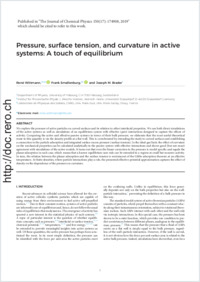Pressure, surface tension, and curvature in active systems: A touch of equilibrium
- Wittmann, René Department of Physics, University of Fribourg, CH-1700 Fribourg, Switzerland - Institut für Theoretische Physik II, Weiche Materie, Heinrich-Heine-Universität Düsseldorf, D-40225 Düsseldorf, Germany
- Smallenburg, Frank Institut für Theoretische Physik II, Weiche Materie, Heinrich-Heine-Universität Düsseldorf, D-40225 Düsseldorf, Germany - Laboratoire de Physique des Solides, CNRS, Univ. Paris-Sud, Univ. Paris-Saclay, Orsay, France
- Brader, Joseph M. Department of Physics, University of Fribourg, CH-1700 Fribourg, Switzerland
-
07.05.2019
Published in:
- The Journal of Chemical Physics. - 2019, vol. 150, no. 17, p. 174908
English
We explore the pressure of active particles on curved surfaces and its relation to other interfacial properties. We use both direct simulations of the active systems as well as simulations of an equilibrium system with effective (pair) interactions designed to capture the effects of activity. Comparing the active and effective passive systems in terms of their bulk pressure, we elaborate that the most useful theoretical route to this quantity is via the density profile at a flat wall. This is corroborated by extending the study to curved surfaces and establishing a connection to the particle adsorption and integrated surface excess pressure (surface tension). In the ideal-gas limit, the effect of curvature on the mechanical properties can be calculated analytically in the passive system with effective interactions and shows good (but not exact) agreement with simulations of the active models. It turns out that even the linear correction to the pressure is model specific and equals the planar adsorption in each case, which means that a known equilibrium sum rule can be extended to a regime at small but nonzero activity. In turn, the relation between the planar adsorption and the surface tension is reminiscent of the Gibbs adsorption theorem at an effective temperature. At finite densities, where particle interactions play a role, the presented effective-potential approximation captures the effect of density on the dependence of the pressure on curvature.
- Faculty
- Faculté des sciences et de médecine
- Department
- Département de Physique
- Language
-
- English
- Classification
- Physics
- License
-
License undefined
- Identifiers
-
- RERO DOC 326788
- DOI 10.1063/1.5086390
- Persistent URL
- https://folia.unifr.ch/unifr/documents/308017
Statistics
Document views: 108
File downloads:
- pdf: 130
